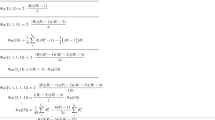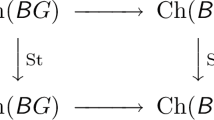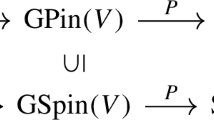Abstract
We consider the tensor square of the basic spin representations of Schur covering groups \(\widetilde{S_n}\) and \(\widetilde{S_n^{'}}\) for the symmetric group \(S_n\). It is known from work of Stembridge that the irreducible components of the tensor square of the basic spin representations for \(\widetilde{S_n}\), for n odd, are multiplicity-free and indexed by hook partitions ([3], pp. 133). In this paper, we derive similar results for \(\widetilde{S_n}\) when n is even, and for \(\widetilde{S_n^{'}}\) when n is arbitrary. We assume that \(n\ge 4,\ n\ne 6\), when discussing \(\widetilde{S_n^{'}}\).
Similar content being viewed by others
1 Introduction
The theory of the covering group \(\widetilde{G}\) of a finite group G is introduced by Schur [2], who investigated the projective representations of G. For a finite group G, there exists a group \(\widetilde{G}\) satisfying the following properties:
(1). There exists a central extension \(1\longrightarrow A\longrightarrow {\widetilde{G}} \longrightarrow G \longrightarrow 1\) such that any projective representation of G over \({{\mathbb {C}}}\) lifts projectively to a linear representation of \(\widetilde{G}\),
(2). \( |A|=|H^2(G,{\mathbb {C}}^{*})|\),
where \(H^2(G,{\mathbb {C}}^{*})\), called the Schur multiplier of G, denotes the second cohomology group with respect to the trivial action of G on \({\mathbb {C}}^{*}\). The group \(\widetilde{G}\) is called the Schur covering group of G.
Each projective representation of G described by Schur can be linearized by a linear representation of \(\widetilde{G}\) [2]. A theorem of Schur states that for \(n\ge 4\), the symmetric group \(S_n\) admits exactly two minimal central extensions, also known as covering groups, \(\widetilde{S_n}\) and \(\widetilde{S_n^{'}}\), both of order \(2\cdot n!\), non-isomorphic for \(n \ne 6\), with corresponding twisted group algebras [1, 2].
In this paper, we investigate the irreducible components of the inner tensor square of the basic spin representation for the Schur covering groups \(\widetilde{S_n}\) and \(\widetilde{S_n^{'}}\). One of the references for the subject of spin representation of the covering groups for the symmetric group \(S_n\) is Hoffman and Humphreys’s book [1]. Representations of the covering groups which do not represent (\(-\,1\)) faithfully (i.e., (\(-\,1\)) maps to \(+1\)) lift to ordinary representations of the symmetric group. Since tensor squares fall in this class, tensor powers of the covering group characters are characters of \(S_n\). This observation underlies our main result. For the Schur covering group \(\widetilde{S_n}\), when n is odd, Stembridge-derived irreducible decomposition for the inner tensor square of the basic spin representations ([3], pp. 133). This decomposition is multiplicity-free and indexed by hook partitions of n. We present similar results for \(\widetilde{S_n}\) when n is even, and for \(\widetilde{S_n^{'}}\) when n is arbitrary.
The plan of the paper is as follows. In Sect. 2, we introduce a quick review of the projective representation theory of \(S_n\), and Clifford theory [2, 3, 5]. In Sect. 3, we describe the basic spin characters of the covering group \(\widetilde{S_n^{'}}\) following Stembridge’s idea. In Sect. 4, we derive the tensor square of the basic spin representation for the covering groups \(\widetilde{S_n}\) (n: even) and \(\widetilde{S_n^{'}}\) (n: odd, even). When n is even, irreducible components are labeled by partitions HOP(n), \(HP(n) \setminus HOP(n)\), where HP(n) denotes the set of hook partitions, and HOP(n) denotes a subset of HP(n) described in Definition 1.
2 Projective representations of the symmetric groups \(S_n\)
A partition \(\lambda \) is any non-increasing sequence of non-negative integers \(\lambda =(\lambda _1,\lambda _2,\ldots )\) containing only finitely many non-zero terms. The number of parts is the length of \(\lambda \), denoted by \(\ell (\lambda )\). And let P(n) be the set of all partitions of n, DP(n) be the set of partitions of n into distinct parts, \(DP(n)^{-}\) be the set of distinct partitions of n in which \(n-\ell (\lambda )\) is odd, and OP(n) be the set of partitions of n with odd parts.
Definition 1
We present some results described by Schur. First, the Schur multiplier of \(S_n\) is given by the following theorem.
Theorem 1
([2])
Let \({{\mathbb {Z}}_{2}}=\{1,z\}\). Next we introduce two groups. The first one is \(\widetilde{S_{n}}\). Let \(\widetilde{S_{n}}\) be the group generated by elements \(t_1,t_2,\cdots ,t_{n-1},z\) subject to the relations:
The other group is \(\widetilde{S_{n}^{'}}\). Let \(\widetilde{S_{n}^{'}}\) be the group generated by elements
\(s_1,s_2,\cdots ,s_{n-1},z\) subject to the relations:
These groups are nonisomorphic for \(n \ne 6\). It is known that \(\widetilde{S_n}\) and \(\widetilde{S_n^{'}}\) are equivalent to Schur covering groups of \(S_n\ (n\ge 4):\)
in which\(f(t_i)=\sigma _i,\ g(s_i)=\sigma _i\), where \(\sigma _i=(i\, i+1) \in S_n\). Furthermore, these are the only Schur covering groups.
It is known that representations of covering groups \(\widetilde{S_n}\) and \(\widetilde{S_n^{'}}\) in which z is represented faithfully as \(-I\) are the spin representation of \(\widetilde{S_n}\)[1]. Within the spin representations of the Schur covering groups, we deal with the basic spin representations which are the smallest faithful representations. The character values of the basic spin representations for the groups \(\widetilde{S_n}\) are given by
Theorem 2
([2])
(1) When n is odd, we have
(2) When \(n =2k\) is even, we have
3 Basic spin representations for the covering group \(\widetilde{S_{n}^{'}}\)
In this section, we construct the basic spin representation of \(\widetilde{S_{n}^{'}}\), using ideas of Stembridge ([3], pp. 99). The following facts correspond to Stembridge’s equation (3.2). The Clifford algebra \({{\mathcal {C}}_n}\) is generated by elements \(\xi _{1},\xi _{2},\ldots ,\xi _{n}\) with the presentation:
\({{\mathcal {C}}_n}\) is a \(2^n\)-dimensional algebra over \({\mathbb {C}}\). As a basis of \({{\mathcal {C}}_n}\), we write \(\xi _{A}=\xi _{a_1}\xi _{a_2}\xi _{a_3}\cdots \), where \(A=\{a_1< a_2< a_3 <\ldots \}.\) We construct the representation for the Clifford algebra \({{\mathcal {C}}_n}\). Let \(M(2^k, {\mathbb {C}})\) be the \(2^k \times 2^k\) complex matrix algebra. When \(n=2k\) is even, a mapping \(\rho \) is defined by
where
By this correspondence, we have
When \(n=2k+1\) is odd, we put \(\xi :=\xi _{1}\xi _{2}\cdots \xi _{2k+1}\). In this case, it is known that
and
This immediately implies following proposition. For any coefficients \(c_{A}\in {\mathbb {C}}\),
Proposition 1
([3], Proposition 3.1)
(1) The irreducible character of \({{\mathcal {C}}_{2k}} \simeq M(2^k,{\mathbb {C}})\) is given by
(2) The irreducible characters of \( {{\mathcal {C}}_{2k+1}} \simeq M(2^k,{\mathbb {C}})\oplus M(2^k, {\mathbb {C}})\) are given by
where \(c_{\xi }\) denotes the coefficient of \(\xi =\xi _{1}\xi _{2}\cdots \xi _{2k+1}\).
The covering group \( \widetilde{S_{n}} \) is realized as a subgroup of Clifford algebra \({C_m}^{*}\) by the following proposition.
Proposition 2
([3], Lemma 3.2) Let \(\tau \) be the mapping defined by
For
if the \((n-1)\times m\) matrix T satisfies the following:
the map \(\tau \) is group homomorphism. Conversely, if \(\tau \) is group homomorphism for \(n \ge 4\), then the matrix T satisfies(*).
There is a bijective correspondence between the basic spin representation \(\widetilde{S_{n}}\) and \(\widetilde{S_n^{'}}\), the passage from a representation \(\tau \) of \(\widetilde{S_{n}}\) to a representation \(\eta \) of \(\widetilde{S_n^{'}}\) being accomplished by multiplying the matrix of \(\tau (g)\) \((g \in \widetilde{S_n})\) by \(i=\sqrt{-1}\) ([1], pp. 22). Therefore, for the above matrix T, taking \(A=iT\), we have the basic spin representation of \(\widetilde{S_n^{'}}\).
Proposition 3
Let \(\eta \) be the mapping defined by
For
if the \((n-1)\times m\) matrix A satisfies the following:
the map \(\eta \) is group homomorphism. Conversely, if \(\eta \) is group homomorphism for \(n \ge 4\), then the matrix A satisfies (**).
The next argument is the analogous result pertaining to \(\widetilde{S_n}\) for Stembridge’s paper ([3], Lemma 3.2).
Now we take
Then we have
Here, if we determine the constants \(a_{j},\, b_{k},\,(1\le j\le n-1,\ 1\le k \le n-2)\) such that \(a_j^2+b_j^2=1,\ a_{j+1}b_j=-\frac{1}{2}\), the mapping
is group homomorphism. From this, we can construct a spin representation of \(\widetilde{S_n^{'}}\):
and
We refer to the map \(\rho \circ \eta \) as the basic representation of \(\widetilde{S_n^{'}}\). Now we calculate the basic spin character values. For \(\lambda =(\lambda _1,\lambda _2,\ldots ,\lambda _{l})\), we define
It can be rewritten:
Here, we consider the element:
This element \(\eta (\sigma ^{\lambda })\) of the Clifford algebra has a constant term only when \(\lambda \) is odd partition. The value is
We put \(\phi _{n}=\mathrm{tr}(\rho \circ \eta )\). From Proposition 1, when \(n=2k+1\) is odd,
Likewise, when \(n=2k\) is even,
For \(\lambda =(n)=(2k)\), we have \(\sigma ^{\lambda }=(12)(23)\cdots (2k-1\,2k)\).
The coefficient \(c_{\xi }\) of \(\xi =\xi _{1}\xi _{2}\cdots \xi _{2k-1}\) is equal to \(a_1a_2\cdots a_{2k-1}=\mathrm{det} A\). Here we calculate detA.
Hence,
The basic spin character of \(\widetilde{S_{n}^{'}}\) is given by
Theorem 3
(1) When n is odd, we have
(2) When \(n =2k\) is even, we have
It is already known that \( \widetilde{S_6} \simeq \widetilde{S_6^{'}}.\) Here, note that the basic spin character \(\phi ^{+}_{6}\) is not isomorphic to \(\zeta ^{\pm }_{6}\). Actually, we have \(\phi ^{+}_{6}\simeq \zeta ^{-}_{321}\). Finally, we show that the basic spin representation is irreducible. Proposition 4 is the analogous result pertaining to \(\widetilde{S_n}\) for Stembridge’s paper ([3], pp. 101).
Proposition 4
The basic spin representations of \(\widetilde{S_n^{'}}\):
(1) When \(n=2k+1\) is odd, \(\rho \circ \eta :\ \widetilde{S_n^{'}} \longrightarrow {{\mathcal {C}}_{n-1}}^{*} \longrightarrow M({2^k},{\mathbb {C}})\),
(2) When \(n=2k\) is even, \(\rho \circ \eta :\ \widetilde{S_n^{'}} \longrightarrow {{\mathcal {C}}_{n-1}}^{*} \longrightarrow M({2^{k-1}},{\mathbb {C}})\oplus M({2^{k-1}},{\mathbb {C}})\) are irreducible.
Proof
Here, by using following formula in [4]:
we have
Therefore
Hence the basic representations are irreducible. \(\square \)
4 Main theorem
Spin representations are faithful representation of the covering group \(\widetilde{S_n}\) and \(\widetilde{S_n^{'}}\) in which z is represented as \(-I\). Therefore, the even tensor powers of the spin representations are linear representations of \(S_n\). Furthermore, the tensor squares in even (respectively, odd) numbers for spin representations are linear representations of \(S_n\) (respectively, spin representations). We describe the decomposition into irreducibles of these tensor squares of the basic spin representations.
When n is even, from Theorem 2 and 3, the Schur covering groups \(\widetilde{S_{n}}\) and \(\widetilde{S_{n}^{'}}\) have two basic spin representations, respectively. We write \({V^{(n)}}^{+}\), (\( {W^{(n)}}^{+}\)) for the representation space with character \({\zeta _{n}^{+}}\), (\({\phi _{n}^{+}}\)). We apply a similar definition to the minus case. Clearly,
Simply, we write \({V^{(n)}}^{\otimes 2}\), (\({W^{(n)}}^{\otimes 2}\)). Immediately, we have
We prepare for achieving our goal. We define the Specht module \(S^{\lambda }\) corresponding to partition \(\lambda \), and write its character as \(\chi _{\lambda }\). By using the Murnaghan-Nakayama’s recursion formulas for \(\lambda \in HP(n)\), immediately we have
Proposition 5
(1)
(2) When n is even, we have
For partition \(\lambda \), the monomial symmetric function \(m_{\lambda }(x)=m_{\lambda }(x_1,x_2,x_3,\ldots )\) is defined by the sum of all distinct permutations of the monomial \(x^{\lambda }=x_{1}^{\lambda _1}x_{2}^{\lambda _2}x_{3}^{\lambda _3}\cdots \). Let \(\Lambda ^{k}\) denote the free \({\mathbb {Z}}\) -module generated by the \(m_{\lambda }\) for all partitions of k, and let \(\Lambda =\bigoplus _{k \ge 0}\Lambda ^{k}.\)
The power sum symmetric functions \(p_{r}(x)\) is defined for \(r>0\) by \(p_{r}(x)=x_1^{r}+x_{2}^{r}+\ldots .\) We use the abbreviation \(p_{\lambda }(x)=p_{\lambda _1}(x)\cdot p_{\lambda _2}(x)\cdot p_{\lambda _3}(x) \ldots \) for any partition \(\lambda \). The ring \(\Lambda _{{\mathbb {C}}}\simeq {\mathbb {C}}\otimes _{{\mathbb {Z}}}\Lambda \) has several \({{\mathbb {C}}}\)-bases, power sum symmetric functions \(p_{\lambda }(x)\), elementary symmetric functions \(e_{\lambda }(x)\), complete symmetric functions \(h_{\lambda }(x)\) and Schur functions \(s_{\lambda }(x)\). For symmetric function \(f \in \Lambda _{{\mathbb {C}}}^{k}\), we write \(f|_{A}\) when condition A is attached to f.
Lemma 1
When \(n\ge 1\), we have
Proof
We use the well-known facts:
We put \(p_{r}(x)=1+(-1)^{r+1}\). From the equation \((***)\), we have
and
\(\square \)
Proposition 6
For \(\lambda =(n-r,1^r) \in HP(n)\), we have
Proof
It is known that
Using Lemma 1, we have
\(\square \)
Now we can prove our main results.
Theorem 4
(1) When n is odd, we have
(2) When \(n =2k\) is even, we have
Proof
From Theorem 2 and 3, we notice that
and
where sgn denotes the sign character of the symmetric group \(S_n\). In other words, for even n, they differ simply by the sign representation of \(S_n\), so that one is obtained from the other by conjugating partitions in the irreducible decomposition. Therefore, it is enough to show that irreducible decomposition of the representation space \({V^{(n)}}^{\bigotimes 2}\) satisfies the above results.
(1). From Theorem 2, we have
Here, recall that the Schur function \(s_{\lambda }(x)\) is given by
We set
in the Schur functions. We have
For \(\lambda \in HP(n)\), from Proposition 6, we have
Therefore, we have
Hence,
Finally, we show that
From Theorem 2, if n is odd, we have \(\zeta _{n}^{2}(1^n)=2^{n-1}.\) It is enough to show that the sum of the dimension of vector spaces labeled by hook partitions equals \( 2^{n-1}\). It is none other than Proposition 5.
(2). From Theorem 2,
For \(\lambda \in HP(n)\),
On the other hand, by using the Murnaghan-Nakayama’s recursion formulas for \(\lambda \in HP(n)\), we have
Hence,
(i). When k is even:
(ii). When k is odd:
From Proposition 5 and Theorem 2, 3, when k is even, we have
When k is odd, we have
Thus, the assertion holds. \(\square \)
Immediately from Theorem 4, we have
Corollary 1
When n is even, we have
Example 1
The basic spin character and linear character tables for the Schur covering groups. (i). \(n=5\)


(ii). \(n=4=2\cdot 2\)


Hence,

(iii). \(n=6=2\cdot 3\)




Hence,

More generally, we can generalize Proposition 5 from Theorem 4.
Corollary 2
(1). when n is odd, for \(\mu \in OP(n)\cup DP^{-}(n)\),
(2). When n is even, for \(\mu \in OP(n),\)
When n is even, there is no \(\lambda \in HOP(n)\) satisfying \(\lambda ={}^{t}\lambda \). Therefore, we have
Corollary 3
When n is even, for \(\mu \in P(n)\setminus (OP(n)\cup DP^{-}(n)),\)
References
Hoffman, P.N., Humphreys, J.F.: Projective Representations of the Symmetric Groups. Oxford University Press, Oxford (1992)
Schur, I.: Über die Darstellung der symmetrischen und der alternierenden Gruppe durch gebrochene lineare Snbstitutionen. J. Reine Angew. Math. 139, 155–250 (1911)
Stembridge, J.R.: Shifted tableaux and the projective representations of symmetric groups. Adv. Math. 74, 87–134 (1989)
Macdonald, I.G.: Symmetric Functions and Hall Polynomials, 2nd edn. Oxford University Press, Oxford (1995)
Weyl, H.: The Classical Groups. Princeton Univ. Press, Princeton, NJ (1946)
Author information
Authors and Affiliations
Corresponding author
Additional information
Publisher's Note
Springer Nature remains neutral with regard to jurisdictional claims in published maps and institutional affiliations.
Rights and permissions
About this article
Cite this article
Aokage, K. Tensor square of the basic spin representations of Schur covering groups for the symmetric groups. J Algebr Comb 54, 135–150 (2021). https://doi.org/10.1007/s10801-020-00972-1
Received:
Accepted:
Published:
Issue Date:
DOI: https://doi.org/10.1007/s10801-020-00972-1




